Ancient clay pots keep food cool underground through a clever combination of evaporative cooling and stable soil temperatures. When you place water-filled clay pots in underground chambers, the porous terracotta allows moisture to seep through its walls. As this water evaporates, it pulls heat from the pot's interior, naturally lowering temperatures by 6-10°C. The surrounding soil acts as insulation, maintaining consistent temperatures between 45-70°F below the frost line. You'll find this method particularly effective when smaller pots nest inside larger ones with moist sand between them. This ancient technique holds countless secrets from civilizations past.
Ancient Egyptian Storage Methods
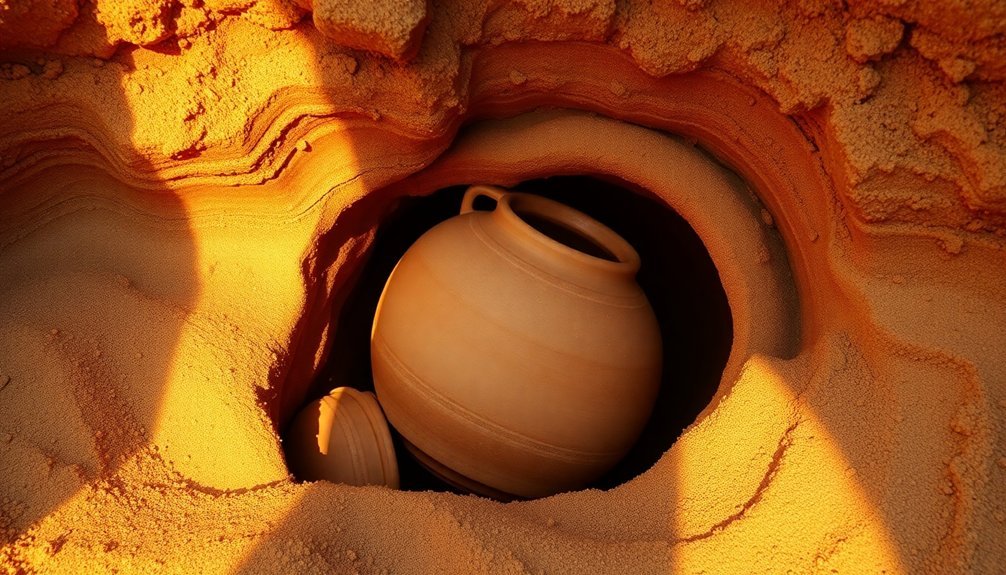
The ancient Egyptians mastered four primary methods of food preservation: drying, salting, fermentation, and curing.
You'll find that they expertly used the hot desert sun and wind to dry fish, poultry, and various other foods, a practice dating back to 12,000 B.C. They'd pack meat, fish, and vegetables in salt or brine to preserve them for extended periods.
When it came to grain storage, you'd be amazed at their sophisticated systems. They built massive silos that could store grain for several years, particularly essential during the annual Nile flooding periods. They also used clay pots to maintain freshness and prevent pest infestations.
They'd only declare wars after securing their harvest, showing how critical these grain stocks were for their civilization.
You'll notice their advanced fermentation techniques in their diverse beverage production. They'd create beer by fermenting grains, which also provided yeast for bread making.
They stored their wines in terracotta amphorae, carefully sealed with clay and leather stoppers. You'll find detailed records on these vessels, including the regnal year and vineyard location.
For meat preservation, they'd use various methods, including slow-cooking in fat and packing in brine or salt.
Underground Clay Pot Science
Modern-day clay pot science reveals a remarkable cooling mechanism that's both elegant and effective.
When you place a clay pot underground, it creates a natural refrigeration system through evaporative cooling. The process works as water seeps through the porous terracotta walls and evaporates from the outer surface, pulling heat away from the pot's interior. The internal aluminum radiator system helps maintain consistent air circulation throughout the pot.
You'll find that the cooling effect can reduce temperatures by 6-10°C, which is significant for food preservation. The system works best when you nest a smaller pot inside a larger one, with damp sand filling the gap between them. This setup mimics natural insulation structures, like beehives, maximizing the cooling effectiveness.
For the system to work effectively, you'll need to position your clay pot setup in a shaded, well-ventilated area and keep the sand consistently moist. You should also cover the top with a wet cloth or sack to maintain ideal humidity levels.
When you follow these principles, you're tapping into a scientific process that's particularly valuable in arid regions without electricity, where the dry air accelerates evaporation and enhances the cooling effect.
Soil Temperature Benefits
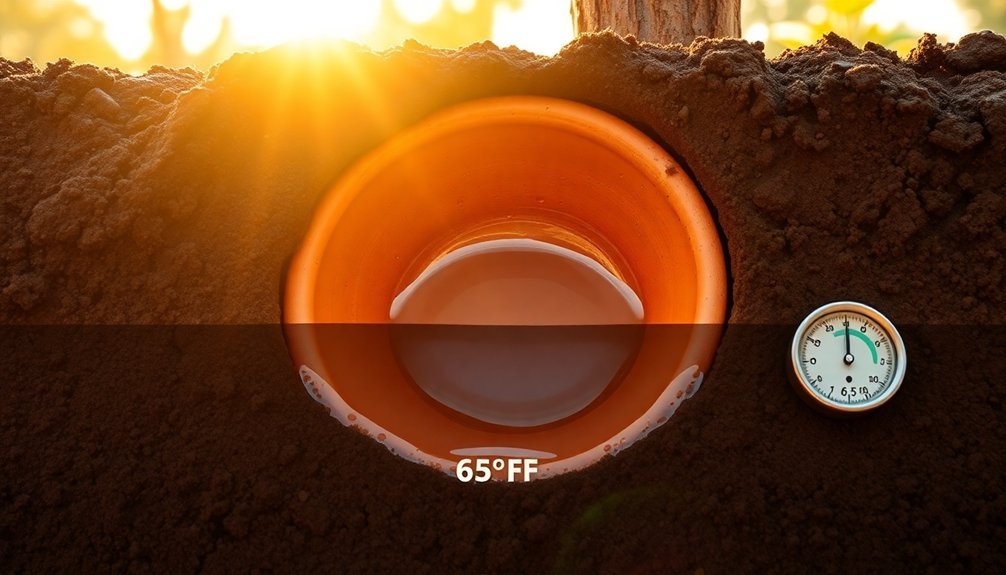
You'll find that ancient clay pots created stable underground temperature zones, offering essential benefits for seed germination and root development through their natural insulating properties.
The pots' placement in underground soil layers helped maintain ideal temperatures for microbial activity and nutrient uptake, even during extreme weather fluctuations above ground. Wet soil conditions within and around the clay pots allowed for slower temperature changes, providing steady growing environments.
Through natural earth heat exchange, the clay vessels regulated soil temperatures around plant roots, creating perfect growing conditions that enhanced both nutrient availability and overall plant health.
Stable Underground Temperature Zones
Buried deep beneath the Earth's surface, temperature zones remain remarkably stable and predictable, making them ideal for ancient clay pot storage. When you dig down 25-30 feet, you'll find temperatures that closely match the average annual surface temperature of your region, ranging from 45°F in northern areas to 65°F in southern locations.
You'll notice that soil temperatures become more constant as you go deeper, with minimal fluctuations compared to surface conditions. Once you reach 15 meters underground, temperature increases by only 0.026°C per meter due to the Earth's internal heat. This stability creates perfect conditions for preserving food and other perishables in clay pots.
The temperature zones you'll encounter depend on your location. If you're in north-east Scotland, you might find temperatures around 8.5°C, while in the Thames Valley, they'll be closer to 11.5°C.
Your latitude and elevation play significant roles – you'll experience vastly different ground temperatures between places like Fairbanks, Alaska (0°F) and Bangkok (85°F). This natural temperature regulation made underground storage an effective preservation method for ancient civilizations.
Natural Earth Heat Exchange
Throughout history, natural heat exchange within the Earth has provided remarkable temperature-regulating benefits.
You'll find that soil temperatures remain surprisingly constant once you dig below the frost line, typically staying between 45°F-50°F in northern regions and 50°F-70°F in southern areas. This stability is due to soil's impressive heat capacity and natural insulation properties.
When you go deeper than 30 feet underground, you'll discover that seasonal temperature fluctuations disappear completely. The soil's high heat capacity allows it to absorb and release heat slowly, creating a reliable temperature-control system that's been used for centuries.
You can take advantage of this natural phenomenon because the ground acts as both a heat source and sink, maintaining consistent temperatures regardless of above-ground weather conditions.
The Earth's natural heat exchange capabilities work perfectly with traditional clay pot storage. As you place these pots in underground spaces, they benefit from both the stable ground temperature and evaporative cooling effects.
The clay's porous nature, combined with the Earth's constant temperature, creates an efficient cooling system that can maintain temperatures up to 10°C below ambient conditions without using electricity.
Insulated Soil Layers Impact
Insulating soil layers creates a remarkable thermal buffer that enhances the Earth's natural temperature-regulating properties. When you properly insulate the soil around underground storage areas, you're tapping into the ground's natural ability to maintain stable temperatures year-round. This insulation mechanism prevents heat loss and helps retain valuable thermal energy within the storage space.
You'll find that insulated soil acts as a powerful thermal mass, much like water or stone. It absorbs heat during warmer periods and releases it slowly when temperatures drop, creating a consistently cool environment for your clay pot storage. The insulation prevents frozen ground from affecting the temperature of the soil beneath your storage area, while also keeping summer heat at bay.
The installation method matters considerably. You can use vertical insulation with rigid foam boards extending 4 feet into the ground, or opt for a "Swedish Skirt" horizontal layout around the perimeter. Both approaches help you maintain ideal soil temperatures for food preservation.
Natural Cooling Mechanisms
Ancient clay pots employ a remarkable natural cooling system that mirrors the human body's perspiration process. When water evaporates from the pot's outer surface, it draws heat away, creating a cooling effect that can lower the internal temperature by up to 10°C below the surrounding air temperature.
You'll find this cooling mechanism works best in specific conditions. The system needs low humidity (under 40%) and temperatures above 25°C to function effectively.
If you're setting up a clay pot cooler, you'll want to place it in a shady, well-ventilated area. Adding wet sand between double-walled pots and covering the top with a damp cloth enhances the cooling effect, though you'll need to add 1-3 liters of water daily to maintain it.
The results are impressive: your fruits and vegetables will stay fresh considerably longer. For instance, you'll keep leafy greens fresh for four days instead of just one.
What makes this system even more attractive is its cost-effectiveness – at $3-40, depending on size and local prices, you're getting a sustainable cooling solution that operates without electricity and uses minimal water.
Clay Pot Construction Techniques
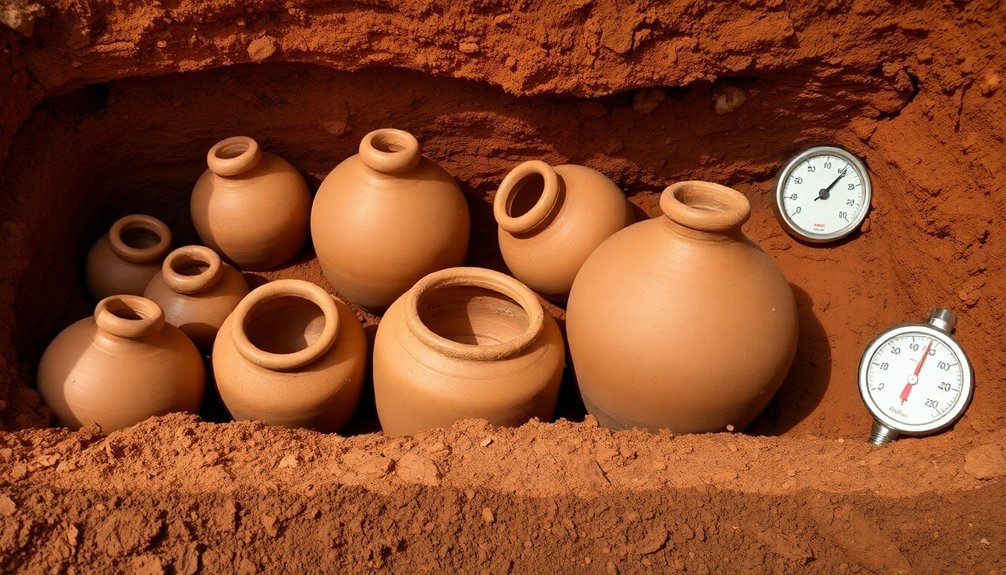
Traditional clay pot construction relies on three primary techniques: pinch pottery, coil building, and slab construction.
In pinch pottery, you'll start with a ball of clay, create a hole with your thumb, and gradually pinch and stretch the clay to form your desired shape. While it's a straightforward method, these pots aren't as durable as wheel-thrown vessels.
Coil building offers more control over your pot's size and shape. You'll roll clay into long coils and attach them to a base, scoring the surfaces and using slip as a clay adhesive. Each coil needs to be firmly pinched together and smoothed with a rib tool to guarantee proper joining.
Slab construction involves rolling clay into flat pieces that you'll cut and shape to form your pot. You can use a puki for rounded bottoms or work on a ware board for flat-bottomed vessels.
Regardless of the technique you choose, you'll need to smooth both interior and exterior surfaces with rib tools, eliminate any holes or lumps, and finish the rim with a damp sponge. For consistency, you might want to use a mold or cardboard template to guide your shaping process.
Best Locations For Storage
Location plays an essential role in preserving clay pots and their contents.
You'll find that underground storage offers the most consistent temperature control, with root cellars maintaining ideal conditions between 32° and 40°F. If you're using buried containers, make certain proper drainage by drilling holes and adding a 4-inch rock layer at the bottom, keeping the container slightly above ground level and covered with straw.
For indoor storage, you can utilize crawl spaces for root vegetables, storing them in breathable bags and wooden crates.
If you're dealing with onions and garlic, convert a spare room or closet into a cool, dry storage area by sealing off vents. Your furnace room or attic works well for potatoes and pumpkins, while bookshelves can hold winter squash.
When storing outdoors, you'll want to take into account mounding techniques, creating insulated pockets with straw and dirt layers.
Don't forget to include proper ventilation and drainage trenches. For better protection against moisture, elevate your storage using platform structures supported by small posts.
This method's particularly effective during monsoon seasons and has proven successful at sites like Yuma Wash.
Food Preservation Through Time
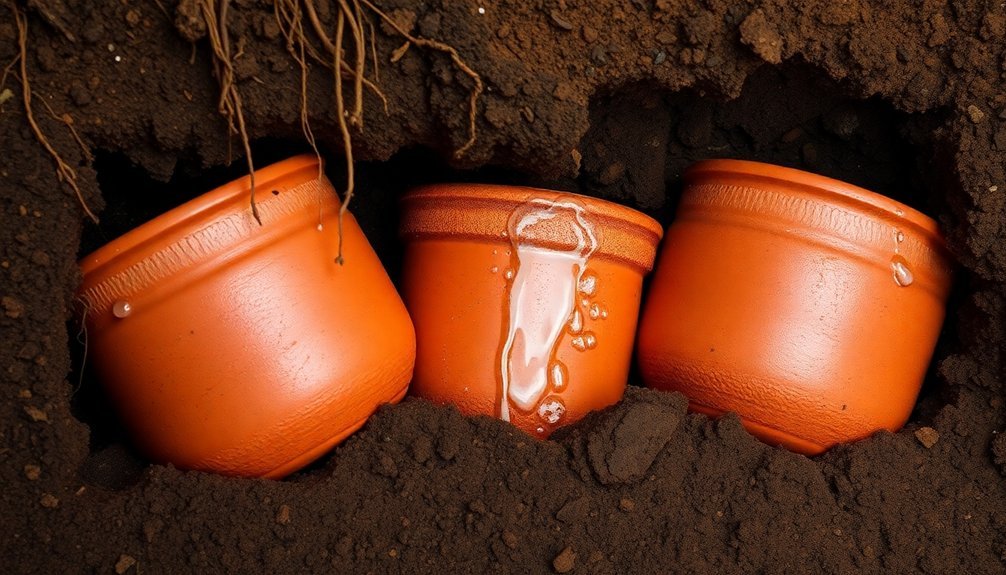
Humanity's quest to preserve food spans thousands of years, with evidence dating back to 12,000 B.C. in the Middle East. You'll find that ancient civilizations mastered various preservation techniques, starting with the simple yet effective method of drying foods using sun and wind.
In areas lacking sufficient sunlight, they built "still houses" to dry foods using fire. You can trace how preservation methods evolved as cultures discovered new techniques. Fermentation and pickling emerged when people noticed that food placed in soured wine or beer stayed edible longer.
They'd use salt for curing meats and fish, while sugaring with honey helped preserve fruits. The ancient Greeks and Romans even developed methods to create jams and jellies using heated sugar and fruit pectin.
In colder climates, you'll see how people took advantage of natural freezing by burying food underground or in snow. They'd also use cool streams, cellars, and caves for storage.
This practice continued until the development of icehouses and iceboxes, which revolutionized food storage before mechanical refrigeration. Later, Clarence Birdseye's quick-freezing technique at low temperatures considerably improved preserved food quality.
Modern Applications Worldwide
While ancient preservation methods laid the groundwork, modern clay pot cooling systems continue to offer practical food storage solutions worldwide. You'll find these systems particularly effective in Sub-Saharan Africa, where they help reduce food loss and extend produce shelf life from one day to over four days.
| Region | Benefits | Requirements |
|---|---|---|
| Arid Zones | Cooling up to 10°C below ambient | Humidity below 40% |
| Coastal Areas | Can use undrinkable water | Daily temperature above 25°C |
| Rural Communities | Cost-effective ($5-$40) | Well-ventilated, shady spot |
| Off-grid Locations | No electricity needed | Water refills 1-3 times daily |
| Agricultural Regions | Extended food storage | Regular sand moistening |
You can easily build these coolers using local materials, with costs varying based on size and location. The system's practicality extends beyond just cooling – it's transforming food security in regions without reliable electricity. In Mali, users report significant financial savings and increased food availability. With proper maintenance, including regular cleaning and keeping the sand moist, these coolers provide a sustainable solution for modern food preservation needs.
Climate Impact On Storage
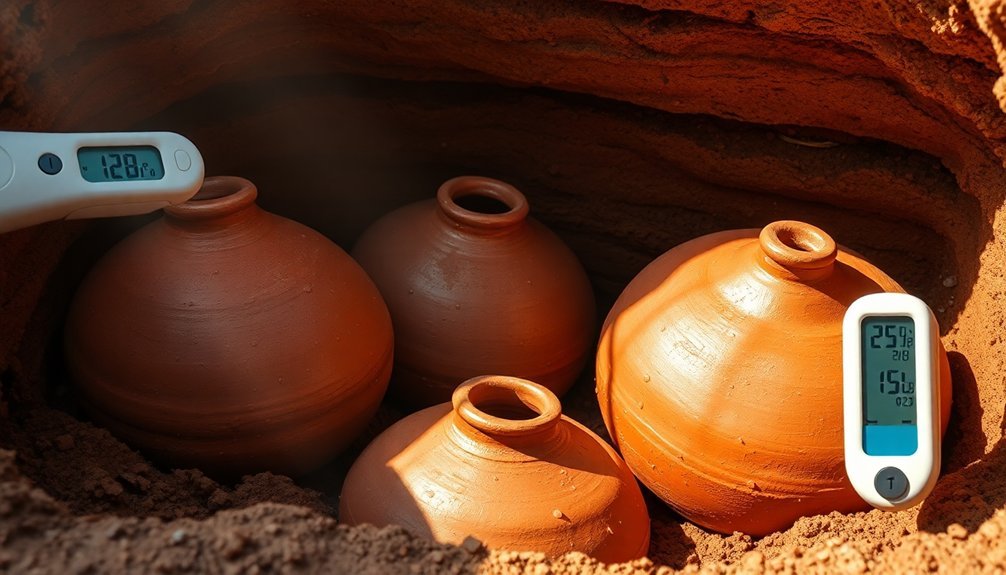
Climate conditions play a pivotal role in determining how effectively clay pot coolers store food. You'll find these systems work best in hot and dry climates, particularly in regions like Sub-Saharan Africa and the Sahel, where high temperatures and low humidity create ideal conditions for evaporative cooling.
In favorable conditions, you can expect your clay pot cooler to lower temperatures by up to 10°C below the surrounding air temperature. This cooling effect is particularly beneficial when you're storing fruits, vegetables, and leafy greens.
What's remarkable is that you can extend the shelf life of leafy greens from just one day to over four days using this method.
You'll need to take into account your local climate when setting up a clay pot cooler. If you're in an arid region, you'll only need to use 1 to 3 liters of water daily to maintain the system.
The cooler's effectiveness depends on regular maintenance – you must keep the sand and cloth consistently moist. While these systems are adaptable to various regions, they're most effective in areas with hot, dry conditions, similar to the environments where ancient Egyptians and Persians first utilized this technology.
Traditional Knowledge Meets Innovation
The remarkable fusion of ancient wisdom and modern engineering has transformed traditional clay pot cooling systems.
You'll find that today's innovators are taking this time-tested technology and scaling it up in exciting ways, creating everything from 50-liter clay refrigerators to building materials that keep entire structures cool.
What's particularly impressive is how local artisans and modern businesses are working together to enhance these designs.
You'll see potters crafting customized refrigerators with floating vessels, while companies develop specialized clay products that maintain the core evaporative cooling principle.
These innovations don't compromise the system's simplicity – they're still electricity-free and rely on basic materials like clay, sand, and water.
You can now benefit from these advancements through various channels, as nonprofits and local businesses collaborate with governments to make these solutions more accessible.
Whether you're looking for a small household cooler or a larger storage solution, there's likely a clay-based option that fits your needs.
This blend of traditional knowledge and contemporary design proves that sometimes the most effective solutions come from respecting ancient wisdom while embracing modern adaptations.
Sustainable Food Storage Solutions
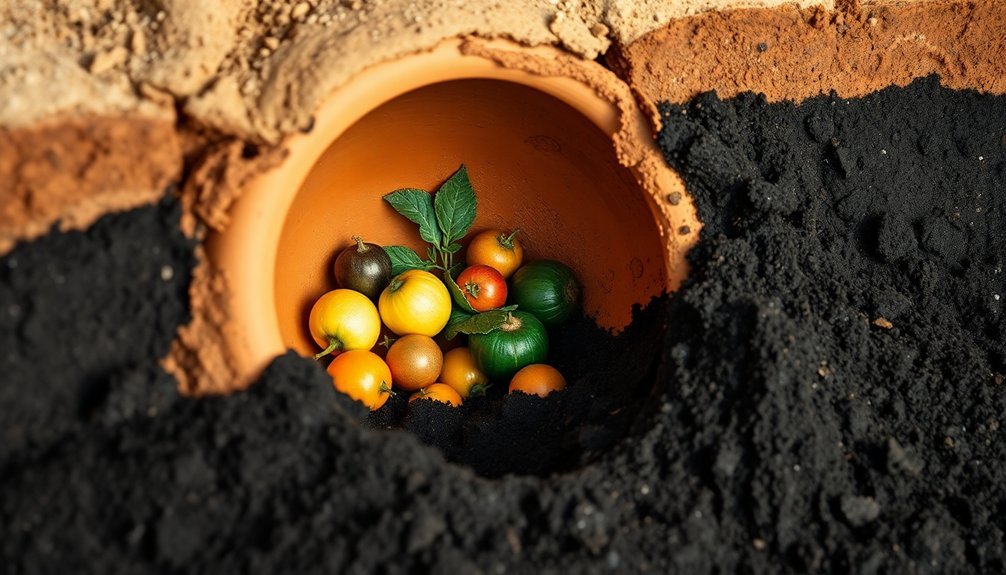
Modern sustainable food storage has evolved far beyond single-use plastics and wasteful containers. You'll find innovative materials like Tritan Copolyester, stainless steel, and food-grade silicone leading the charge in eco-friendly storage solutions.
These materials aren't just sustainable – they're built to last, with products like INKA's containers offering 40 times more uses than conventional options.
You can choose from a range of sustainable containers that fit your specific needs. Stainless steel options from ECOlunchbox won't absorb bacteria or leach chemicals, while Stasher's silicone bags are free from harmful substances like BPA and phthalates.
For traditional cooling methods, clay pot coolers provide an electricity-free solution using simple evaporative cooling principles.
The environmental impact of these solutions is minimal. INKA's Cradle to Cradle Bronze certification guarantees sustainable production with less than 0.1% material waste.
You'll find these products are both versatile and practical – they're dishwasher safe, come in modular sizes, and serve multiple purposes.
When combined with traditional storage methods like root cellars, you're getting a thorough approach to sustainable food storage that's both environmentally conscious and highly effective.
Frequently Asked Questions
Can Clay Pot Coolers Be Used to Store Dairy Products Safely?
You shouldn't store dairy products in clay pot coolers as they can't maintain the low temperatures needed. The high humidity and inconsistent cooling will cause spoilage and potential health risks from bacterial growth.
How Do Underground Clay Pots Affect the Taste of Stored Foods?
Your food's taste stays vibrant in underground clay pots as they regulate moisture and allow slow circulation. You'll notice the clay can impart subtle earthy flavors while preserving your food's natural taste profile.
What Maximum Depth Should Clay Pots Be Buried for Optimal Cooling?
You shouldn't bury clay pots at all – they work best above ground in well-ventilated areas. The cooling effect relies on surface evaporation, not burial depth. Place them in shady spots for ideal performance.
Do Clay Pots Need Special Treatment Before First-Time Underground Storage Use?
You'll need to clean your clay pots thoroughly, soak them in water for 24 hours to enhance porosity, and let them dry completely. Then seal any cracks with food-safe sealant before first use.
Can Multiple Clay Pots Be Stacked Vertically Underground for Increased Storage?
You can stack multiple clay pots vertically underground, but you'll need proper support structures and careful spacing. It's crucial to use descending pot sizes and guarantee adequate drainage between each level for effective cooling.
In Summary
You'll find that ancient clay pot storage methods remain relevant today, combining time-tested wisdom with modern sustainability needs. Whether you're exploring alternative cooling methods or seeking eco-friendly food storage, these underground systems offer practical solutions. By understanding how soil temperature and clay's natural properties work together, you're tapping into a centuries-old technique that's both effective and environmentally conscious.

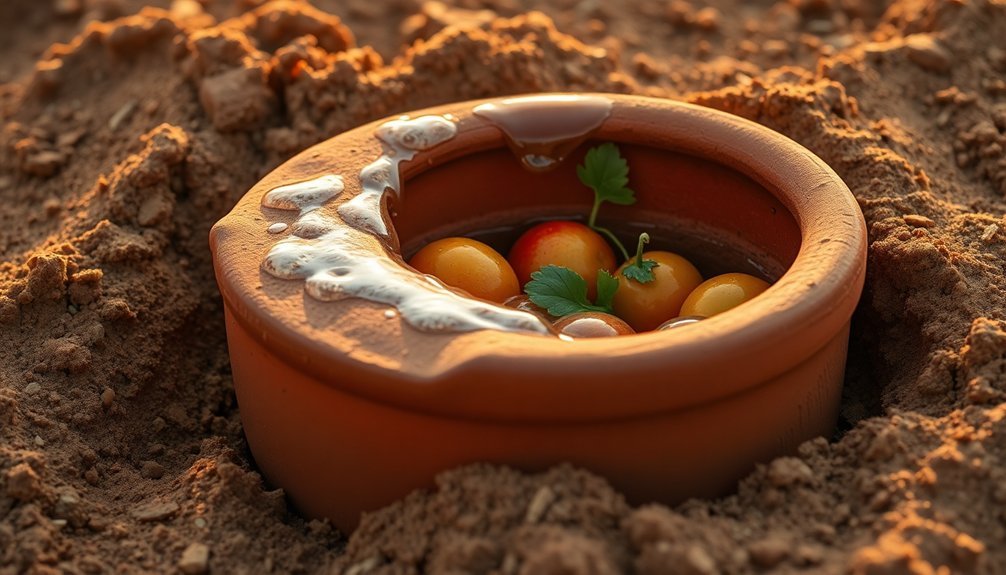



Leave a Reply